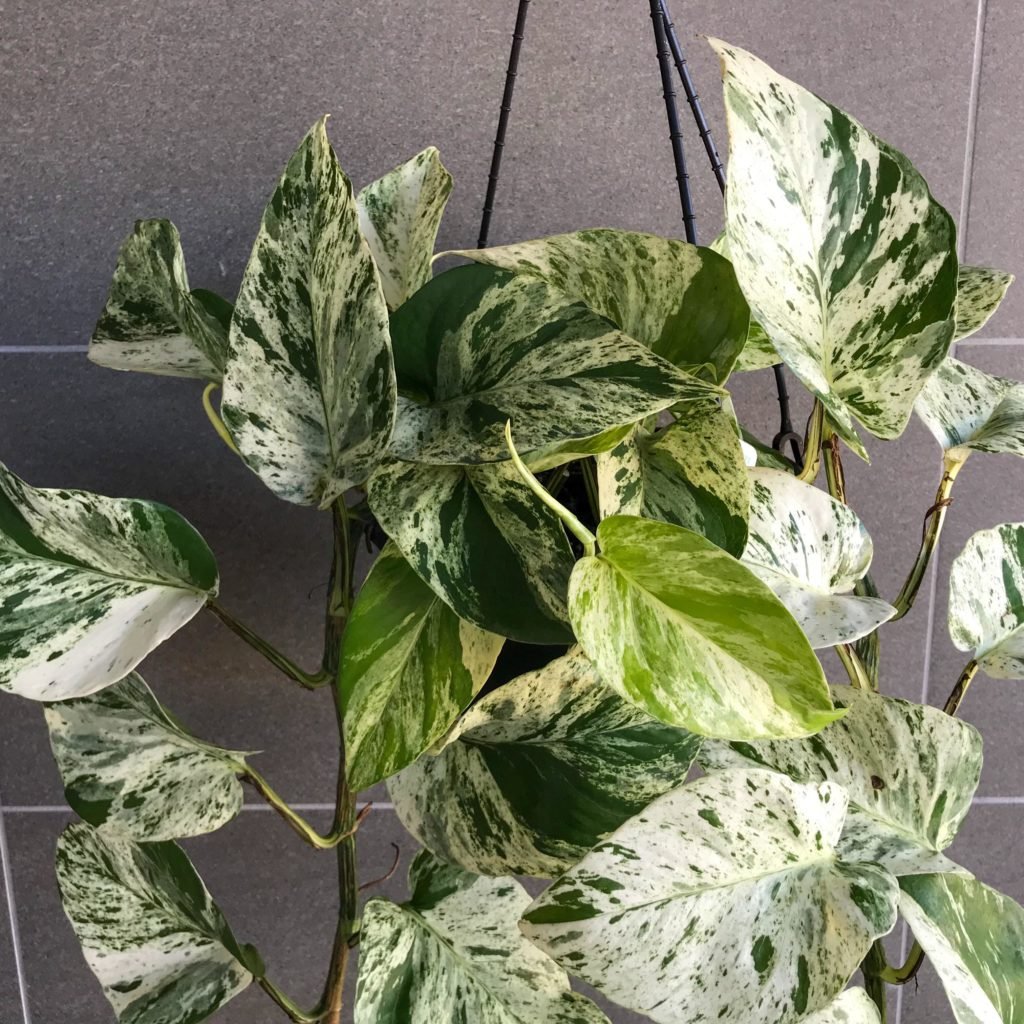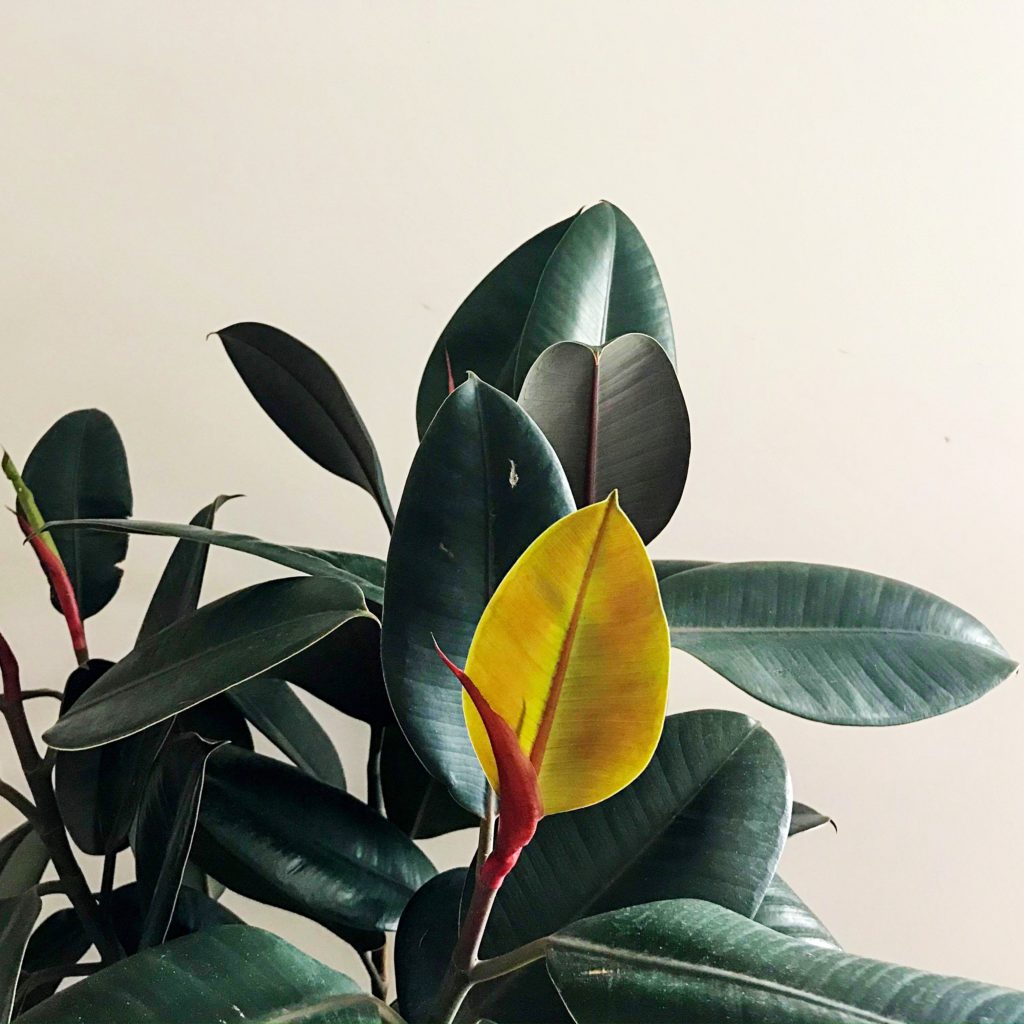Epipremnum Aureum ‘Marble Queen’

Marble Queen Pothos Quick Overview
| Full Size | 6-10 feet |
| Light | Medium-bright indirect |
| Temperature | 65-85°F (18-29°C) |
| Humidity | 40-60% |
| Cost | $ |
| Care Level | Easy |
| Toxicity | Toxic |
The Marble Queen Pothos is one of the many popular houseplants that is part of the Araceae family. This Pothos is definitely a must have in your plant collection with its beautiful marbled green and white variegated foliage. Not only do they look pretty, they are hardy and easy to care for.
Marble Queen Pothos is a fast growing plant that loves to trail. You can provide your plant with a trellis or stake for it to climb up, or have it in a hanging pot for it to trail over the edge of a shelf. However you choose to show off your plant, it will never let you down.
Size
Marble Queen Pothos are extremely fast growers when kept indoors with proper care. The vines of a Marble Queen plant can reach up to 6 to 10 feet in length. To encourage fast growth, it’s important to provide your plant with the correct lighting, feeding and watering.
If you notice your plants growth rate slowing, here are some things you should look out for:
- Location – Marble Queen grow best in medium to bright indirect lighting. Make sure your plant is located in a spot where it is receiving adequate lighting.
- Nutrients – Feeding your plant regularly during the growing period will provide the nutrients your plant needs to assist in fast and healthy growth.
- Pot Size – With your Marble Queens growth being so fast, this means your plant can become root bound. Providing your plant with a slightly larger pot will encourage it to continue growing.
Marble Queen Light Requirements
Marble Queen Pothos prefer to be positioned in medium to bright indirect light for best growth and requires this to thrive. It’s important to keep this plant out of direct harsh sunlight as this will cause the foliage to burn. An east-facing window will be the perfect spot to house your Marble Queen.
If your Marble Queen is housed in a spot where there is direct sunlight, you can add curtains or blinds to the window to help diffuse the sunlight to stop the leaves from being burnt.
If your Marble Queen is housed in a spot where it doesn’t receive adequate lighting, you will notice the new growth will grow without the white swirls. You can resolve this by positioning your plant to somewhere that has brighter indirect light.
Temperature
Marble Queen Pothos aren’t too fussy when it comes to indoor temperatures and will happily live in temperatures between 65-85°F (18-29°C). However, if you can, you should try to avoid any sudden temperature changes.
During the winter and summer, try and keep your Marble Queen out of the direct airflow from air conditioners and heating units.
Humidity
Marble Queen Pothos will live in your average household humidity however, they will thrive when humidity is kept around 40-60%. If you notice your plants leaf tips are starting to brown, this can be an indication that the air is too dry is. Misting your plant or making a humidity tray will assist in providing more humidity.
If your plant is in a spot with low humidity, see how you can increase the humidity in your home here.
Watering Requirements
You can expect your Marble Queen Pothos to require water at least once a week however, be sure to check the soil before watering to avoid over-watering and root-rot. As a general rule, stick your finger in the soil and if the top 3-5cm of soil is dry, you can give your plant a drink. It’s better to let your plant dry out between watering so it doesn’t stay too wet. Give your plant enough water so that it starts free draining from the bottom of the pot.
A sign that your Marble Queen is thirsty is when the leaves are soft and droopy. Black leaves are a good indication that your plant has been over-watered and yellowing leaves can indicate that you’ve left your plant a little too long without watering. Your plant will require more water during the warmer months and less during the cooler months.
Fertilizing requirements
It’s recommended that you should fertilize your Marble Queen monthly during the growth period (Spring-Autumn) with a general houseplant fertilizer. When fertilizing your Marble Queen, you can follow the instruction on the fertilizer bottle or you can dilute it to half-strength just to be on the safe side.
An alternative to a liquid fertilizer that you could use instead is a worm compost or a liquid seaweed solution. During the cooler months you should reduce fertilizing. Regular feeding during the growth period will provide your plant with the nutrients it needs to promote healthy growth.
Soil Requirements
Like most other houseplants, Marble Queen Pothos require a soil that is well draining. It’s important that you use a soil that is nutrient rich, aerated and well draining to avoid problems like root-rot. A heavy, clay like soil will hold too much moisture which makes the soil waterlogged and causes the roots to rot. Adding perlite or sand to any general potting mix will assist in approving drainage.
Not only should you think about the soil you’ll use, you will need to consider the pot size. You don’t want to use a pot that is much larger than the plants root ball. Using a pot with drainage holes will help prevent over-watering and stop the soil from becoming water-logged.
Diseases & Pests
You should always check your plants for pests to avoid infestations and possible plant deaths. The most common pests that you may encounter on your Marble Queen are Thrips and Mealy bugs. If you catch them early, removing them from your plant can be easy. You can use rubbing alcohol on a cotton swab or make your own homemade solution with dish soap to wipe them off.
There are a few things you can do that will assist in preventing any pest infestations. The things you can try are:
- Checking new plants for pests or isolating new plants for up to a week.
- Check your plants every few days for pests.
- Trim off any dead or dying leaves.
- Wipe down leaves if you notice them getting dusty.
- Keeping your plants healthy. A healthy plant will be able to handle an infestation better than those that aren’t as happy.
- Isolate any plants that have pests.
One of the most common diseases that you may encounter with your Marble Queen is Root-rot. Using a well draining soil, a pot that’s not too large and checking the soil before watering can all help with preventing over-watering which leads to root-rot. For a wide range of information on combating a large range of indoor plant diseases and pests click here.
Marble Queen Toxicity
Marble Queen Pothos are considered to be toxic to cats and dogs when eaten. Similar to other plants in the Araceae family, the leaves contain insoluble calcium oxalate crystals. Eating the stem or a leaf from the plant may cause vomiting, drooling, lack of appetite and mouth and stomach irritation.



